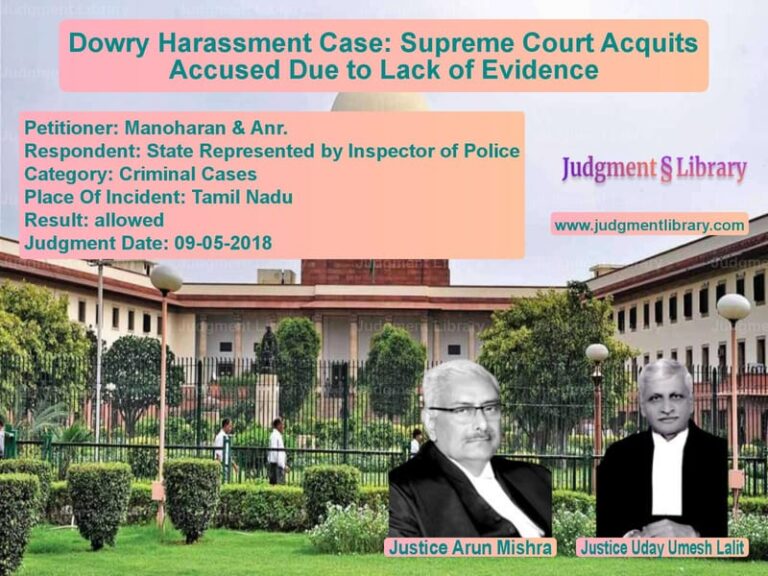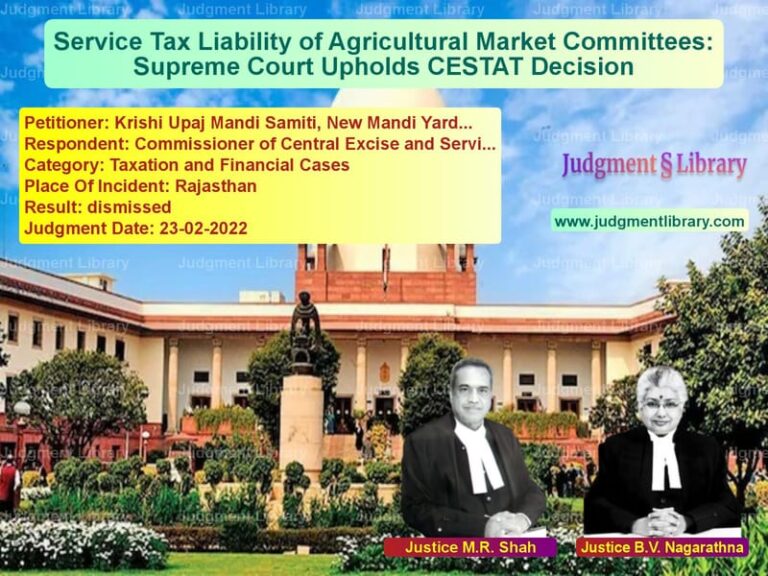Acquittal in Murder Case: Supreme Court’s Ruling on Circumstantial Evidence
The case of Malaichamy & Another vs. The State of Tamil Nadu revolved around the conviction of the appellants for murder under Sections 302 and 449 of the Indian Penal Code (IPC). The Supreme Court ultimately overturned their conviction, emphasizing the importance of proving guilt beyond a reasonable doubt in cases based on circumstantial evidence.
The appellants were accused of trespassing into the house of Velusamy, a Tamil Nadu Legislative Assembly member, and murdering his 17-year-old son, Harish Kumar. The prosecution relied on circumstantial evidence, including the ‘last seen’ theory, motive, and the recovery of weapons.
Background of the Case
The prosecution’s case was based on the following sequence of events:
- Accused Nos. 1 and 2 were related to the complainant, Velusamy.
- Velusamy had previously kept Rs. 13,00,000 for safe custody for Pattai Muniasamy, the uncle of the accused, which was later returned.
- A relationship between Mohankumar (son of Muniasamy) and Kalaiselvi (daughter of Velusamy’s cousin) resulted in a dispute when the marriage proposal was refused.
- Velusamy refused to allow Muniasamy to become a partner in his liquor business.
- Accused No. 2 was removed from his job in a government Fair Price Shop, and Velusamy declined to intervene.
- On 21st June 1998, the victim, Harish Kumar, was found murdered inside his house.
Petitioner’s Arguments
The appellants contended that:
- The entire case was based on circumstantial evidence, with no direct proof linking them to the crime.
- The prosecution failed to establish a complete chain of evidence that ruled out all other possibilities.
- The ‘last seen’ evidence was unreliable, as the witnesses (PW-4 and PW-5) came forward late and their testimony contained contradictions.
- The motive suggested by the prosecution was weak and did not justify committing murder.
- The recovery of weapons was improper, as the police failed to seal them at the time of seizure, making tampering possible.
Respondent’s Arguments
The prosecution argued that:
- The accused were last seen near the house of the deceased in the early morning of the murder, as confirmed by PW-4 and PW-5.
- The appellants had a strong motive to commit the crime due to the financial dispute and personal animosity.
- The recovery of two knives from Accused No.1 supported their guilt.
- The circumstantial evidence, when taken together, was sufficient to establish guilt beyond reasonable doubt.
Supreme Court’s Observations and Ruling
The Supreme Court examined the case in detail and ruled in favor of the appellants, acquitting them. The key observations made by the Court were:
1. Weakness of Circumstantial Evidence
The Court emphasized:
“The Court should satisfy itself that the various circumstances in the chain of evidence must have been established clearly and that the completed chain is such as to rule out a reasonable likelihood of the innocence of the accused.”
The Court found that the prosecution failed to establish such a conclusive chain.
2. Unreliability of ‘Last Seen’ Witnesses
The Supreme Court dismissed the ‘last seen’ theory, stating:
“The testimony of PW-4 and PW-5 is unreliable… If they had really seen the accused near the victim’s house, they would not have missed the opportunity to state this vital fact immediately.”
The delay of over a week in recording their statements created doubts about their credibility.
3. Motive Not Strong Enough
The Court ruled that the suggested motives were weak:
“Even if it is possible that a person might be murdered due to a grouse against his parents, the circumstances here do not disclose strong enough reasons.”
The dispute over money, failed marriage proposal, and job dismissal were not directly connected to the victim.
4. Faulty Weapon Recovery Process
The Court found serious lapses in the handling of weapons:
“After the seizure of the knives, the same were not sealed at all, which made it possible for them to be tampered with or replaced.”
The Court ruled that such flawed evidence could not be relied upon.
5. Benefit of Doubt and Acquittal
Based on these observations, the Court concluded:
“The accused are entitled to the benefit of doubt and are entitled to be acquitted.”
The conviction by the trial court and the High Court was set aside.
Conclusion
This ruling reaffirms the principle that circumstantial evidence must be conclusive and leave no reasonable doubt about the guilt of the accused. In cases where the prosecution fails to establish a complete chain of evidence, the accused must be given the benefit of doubt.
The judgment sets a precedent in murder trials, ensuring that convictions are based on solid and indisputable evidence rather than mere suspicion or weak circumstantial links.
Petitioner Name: Malaichamy & Another.Respondent Name: The State of Tamil Nadu.Judgment By: Justice Mohan M. Shantanagoudar, Justice Dinesh Maheshwari.Place Of Incident: Tamil Nadu.Judgment Date: 23-01-2019.
Don’t miss out on the full details! Download the complete judgment in PDF format below and gain valuable insights instantly!
Download Judgment: Malaichamy & Another vs The State of Tamil N Supreme Court of India Judgment Dated 23-01-2019.pdf
Direct Downlaod Judgment: Direct downlaod this Judgment
See all petitions in Murder Cases
See all petitions in Bail and Anticipatory Bail
See all petitions in Judgment by Mohan M. Shantanagoudar
See all petitions in Judgment by Dinesh Maheshwari
See all petitions in allowed
See all petitions in Quashed
See all petitions in supreme court of India judgments January 2019
See all petitions in 2019 judgments
See all posts in Criminal Cases Category
See all allowed petitions in Criminal Cases Category
See all Dismissed petitions in Criminal Cases Category
See all partially allowed petitions in Criminal Cases Category







